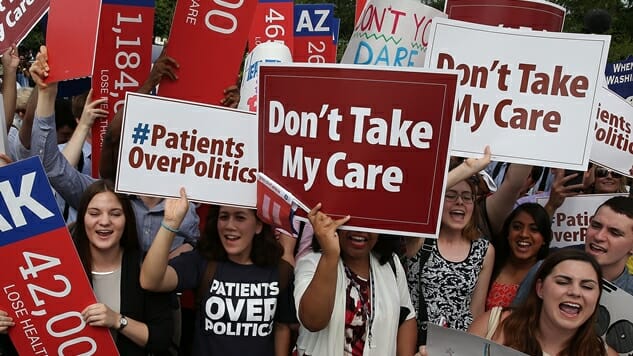Trump’s Executive Order Provides a Spark for the Obamacare Movement
Photo by Mark Wilson/Getty
Many Women’s Marchers held signs demanding “Save the ACA,” on Saturday. They’re not the only ones concerned about the repeal of the Affordable Care Act (ACA). Across the United States, thousands of people are posting on social media, asking others to call their Congressional delegation to support the ACA, while others share personal stories.
For his first act in office, President Donald Trump signed an Executive Order that will “minimize the unwarranted economic and regulatory burdens” of Obamacare.
Twitter user @mattbc is a 34-year-old patient who is currently covered by the ACA. Matt was diagnosed with Crohn’s disease, an inflammatory bowel condition, in 2004. Medical bills of up to $50,000 began to roll in. His private insurer ignored his doctor’s repeated requests for medication coverage for three months, as he “was literally wasting away,” according to Matt. An attorney had to be hired, and the treatment was then approved.
Romneycare eventually gave Matt access to affordable healthcare, followed by Obamacare, which allows expanded access into the state Medicaid program: MassHealth. Because illness can cause sick days from work and long hospital stays, income often declines, and the ACA kicks into effect to cover expensive procedures. Matt spent several intermittent months in 2015 as an inpatient, receiving nutrients via IV.
He told Paste, “The ACA gives us the freedom to make a living in a way that accommodates the realities of living with a chronic illness.”
Matt is worried about the law’s potential repeal in the face of these executive orders. “High-risk pools, block-granting Medicaid, doing away with the prohibition on pre-existing conditions are all dangerous moves that can kill real people,” he explained. Although there is panic in liberal circles, it remains to be seen how Trump’s executive order will impact the law.
What Is an Executive Order?
Executive orders are directives from the President intended to advise specific agencies, and are granted through Article 2 of the Constitution. Only Congress can repeal a law, but an executive action or order can lay the foundation for which way an administration’s policy can go. Trump has promised to repeal all (and sometimes certain) aspects of Obamacare since his campaign began.
The order allows the Secretary of Health and Human Services (HHS) and other heads of departments to waive, defer, delay, or grant exemptions from “any fiscal burden” on States, individuals, health providers, insurers, and makers of medical equipment for medications. Although there is only an acting head of HHS, the order leaves a very broad window for interpretation of what a fiscal burden is.
Trump and Congressional Republicans are currently in negotiations about how the legislation will repealed, and how and which parts will be replaced.
How Could This Impact the Country?
One of the ACA’s most debated provisions is the individual mandate, which requires shared responsibility for taxpayers in the healthcare market. Revoking it would allow people who don’t think they need healthcare to leave the insurance pool. There is currently a $695 penalty fee, per adult, for people making less than $83,400. If you make more than that, you pay 2.5 percent of your yearly household income.
The educated theory is that only the old and chronically ill will remain in the pool, leading to higher costs. Matt said, “If you wanted to cripple the ACA, there’s no better target than removing the individual mandate.”
Timothy Jost is a professor of law at Washington and Lee University who specializes in healthcare policy, and has written extensively about the Affordable Care Act. He talked to Paste about the actions that insurers could take in the coming months. Jost explained, “In a worst case scenario, if the House and Trump administration settled the Sebelius case and stopped paying cost-sharing reduction payments to insurers, you would have insurers leaving the marketplace as quickly as they could within weeks or months.” Patients enrolled in the ACA would start losing financial assistance within weeks.
Jost encourages Americans to continue signing up for the ACA through the end of the enrollment period, which ends January 31st. He said, “Should people sign up in the next week? Yes, go for it. The big question is whether insurers will be coming back for 2018.”
According to a recent report by the Congressional Budget Office the repeal of part of the law in 2015 will have a fairly large impact. Further changes, like the repeal of the Medicaid expansion that Matt benefits from, will increase the number of uninsured from 18 to 32 million over the next few years.
Premiums purchased directly from insurers will increase by 20 to 25 percent with the 2015 cut, and for further cuts, up to around 50 percent. Regardless of your take on how HHS will interpret Trump’s order, or how Congress will dismantle Obamacare, there can be no doubt that change is coming.







































